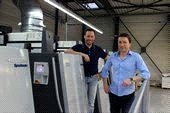Offset Printing
French commercial printer Simon Graphic looking to grow with integrated solution from Heidelberg

Thursday 03. July 2014 - Speedmaster XL 106 LE UV boosts productivity by over 30 percent?
Prinect integrates new Suprasetter 106, Stahlfolder KH 82, and Stitchmaster ST 500 in printing process?Only print shop in France with fully carbon-offset equipment and production operations
“Market developments are forcing us to invest in cutting-edge technology so as to keep up with the competition and meet current delivery time, price, and quality requirements,” says François Simon, Technical Director of Simon Graphic, in summing up the print media industry’s demands. This print shop – which is based in the French town of Ornans, has a 35-strong workforce, and generates annual sales of over EUR 5 million – therefore needs equipment that makes it more productive, more flexible, and more innovative. As a long-standing customer of Heidelberg Druckmaschinen AG (Heidelberg), Simon Graphic appreciates the company’s solutions portfolio. Last year, it installed a Speedmaster XL 106 five-color press with coating unit and energy-saving LE UV drying technology (LE stands for low energy). A Suprasetter 106 platesetter with Multi Cassette Loader, a fully automatic Stahlfolder KH 82 folding machine, and a Stitchmaster ST 500 saddlestitcher – the first machine in this series to be installed in France – have recently been added. The Prinect print shop workflow ensures full integration of all the equipment.
This integrated solution from Heidelberg saves Simon Graphic a great deal of energy, while the individual machines’ high levels of automation and end-to-end color management lead to a significant reduction in paper waste. Simon Graphic is the only print shop in France to work with fully carbon-offset equipment – from prepress and press right through to postpress operations. All CO 2 emissions generated during production and transportation are offset in full.
LE UV shortens delivery times and offers customers new options?”In my printing career there have been three revolutionary developments – Computer-to-Plate, Prinect Inpress Control, and the launch of LE UV technology. We first encountered Prinect Inpress Control in 2009 with the delivery of our Speedmaster XL 75, which was also the first press of this type installed in France. The system ensures consistently uniform inking and optimum print quality. Naturally, the Speedmaster XL 106 with LE UV technology is also equipped with Prinect Inpress Control,” says Simon.
According to his brother Antoine Simon, the print shop’s Commercial Director, LE UV technology is ideal for meeting customers’ demands for ever shorter throughput times and ever shorter runs. “LE UV makes us more flexible and opens up new opportunities. For example, we’re now able to process substrates that are considered to be problematic just as easily as standard paper. When it comes to paper for creative applications, we achieve top results without any significant difficulties in production. Dispensing with a protective coating enables our customers to benefit from the paper’s natural properties and texture as well as sharper color contrasts. Thanks to the quality and exceptional gloss of the coatings, complex special effects can be achieved without using powder and with lower energy consumption,” he explains.
The new Speedmaster XL 106 currently prints exclusively with LE UV inks, but the coating unit supports both LE UV and conventional UV coatings. This makes the press ideal for Simon Graphic’s customers, most of whom are looking for high-quality print products with a wide range of coatings, including high gloss, matt, and silk matt.
In addition to offering added value for customers, enhanced productivity throughout the production process also delivers cost-efficiency and helps the company meet environ-mental targets. “Simply by dispensing with powdering, we’ve raised productivity in perfecting printing by 30 percent. All print sheets are output to a perfect standard, regardless of substrate and print speed, which we usually harness to the full up to the maximum of 18,000 sheets per hour. The time saved in postpress is impressive and our printers’ work is made much easier. A detailed analysis of production times and costs with the Prinect Pressroom Manager revealed that the productivity gains achieved more than compensate for the higher costs of the consumables,” sums up François Simon.?
